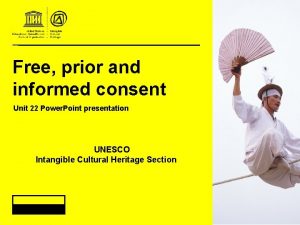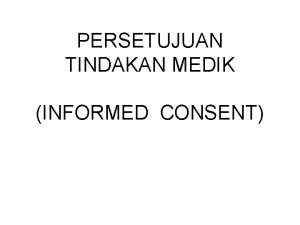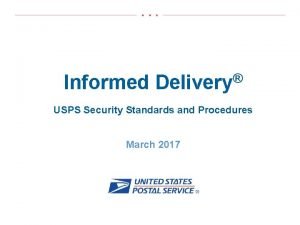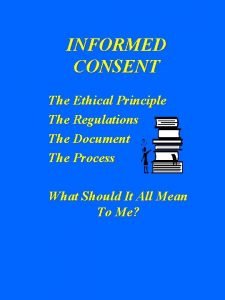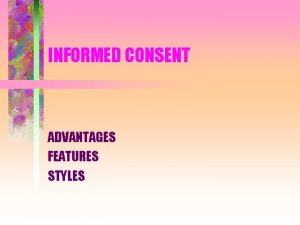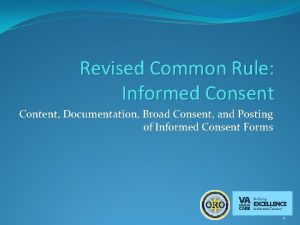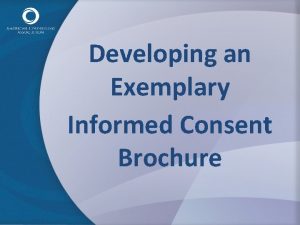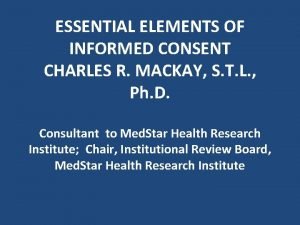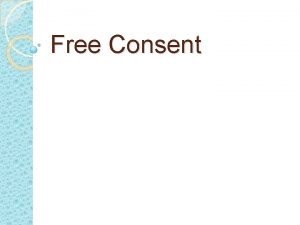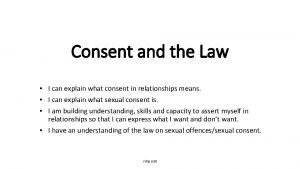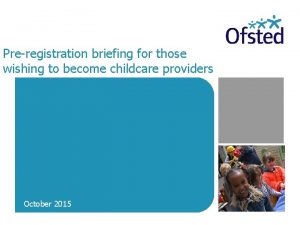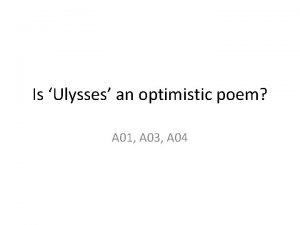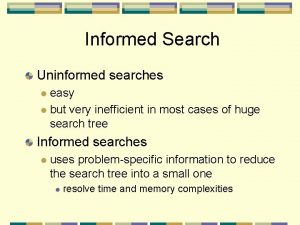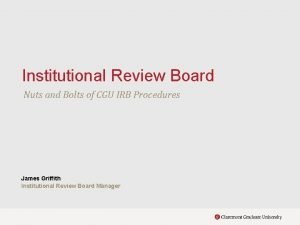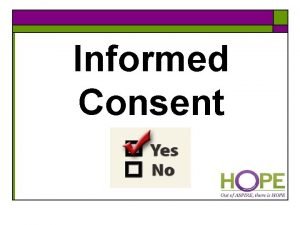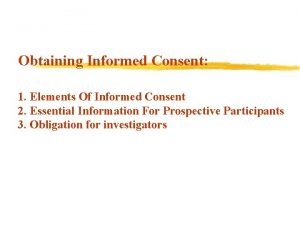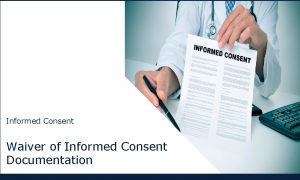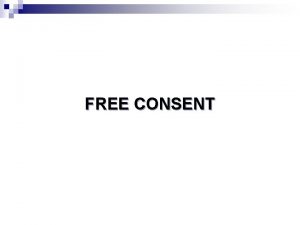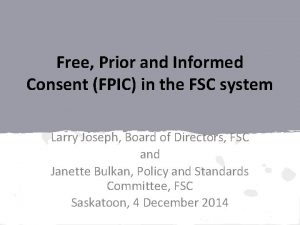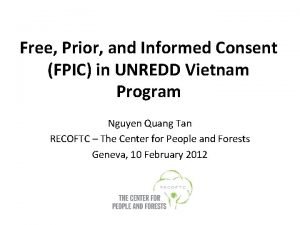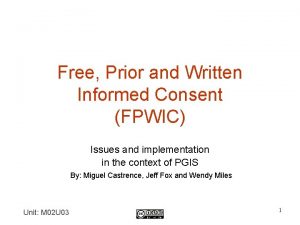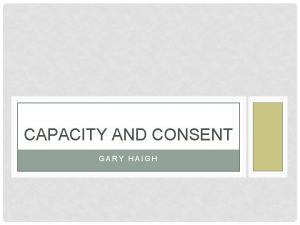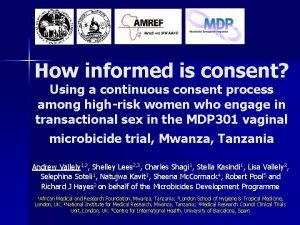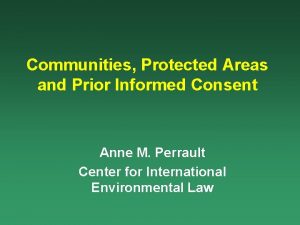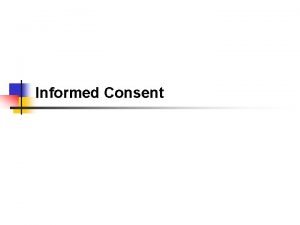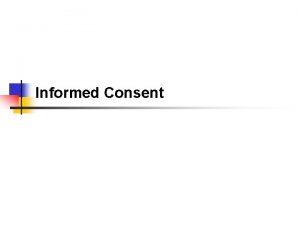Free prior and informed consent Unit 22 Power




















- Slides: 20

Free, prior and informed consent Unit 22 Power. Point presentation UNESCO Intangible Cultural Heritage Section

In this presentation … • • • 2 Why free, prior and informed consent? An emerging standard for the rights of indigenous peoples Free, prior and informed consent and the Convention Why ‘free’? ‘prior’? ‘consent’? Inventorying Who can provide consent? Protection Positive enabling features Creating agreements Key points to consider

Why free, prior and informed consent? 3 • Most ICH consists of traditional cultural expressions and traditional knowledge which are not covered by copyright legislation • Though community ownership of culture and ICH is recognised and supported by the Convention there are few countries which have rights for communities. • UNESCO conventions deal with State Parties and not communities. Free, prior and informed consent provides an instrument for communities • Increasing awareness of communities who want to have rights in how their traditions are used, exploited and applied • An emerging standard for the rights of indigenous people. • UNESCO, UN, World Intellectual Property Organization

An emerging standard for the rights of indigenous people UN Declaration on the Rights of Indigenous Peoples • Article 11 • Article 12 • Article 19 4

Free, prior and informed consent Ethics 5 Legal Instrument

Free, prior and informed consent and the Convention (1) Free, prior and informed consent required and process to be described • Nomination • Safeguarding Free, prior and informed consent recommended • Inventorying 6

Free, Prior Free prior Informed and informed Consent and the ICH consent and. Convention the Convention (2) • Different safeguarding measures foreseen in the Convention require the free, prior and informed consent of the community concerned. • Free, prior and informed consent is required for the development and submission of nomination files to the Convention’s Lists. • Community consent is also required when a State Party nominates a practice for selection as a best safeguarding practice (OD 7, P. 5) or when it prepares an awareness-raising activity that concerns the ICH of one or more specific groups (OD 101(b)). 7

Free, Prior Free prior Informed and informed Consent and the ICH consent and. Convention the Convention (3) • Selection criteria for inscription on the Urgent Safeguarding List, for example, includes the following: • U. 4 The element has been nominated following the widest possible participation of the community, group or, if applicable, individuals concerned and with their free, prior and informed consent. • The Consultative Body charged with the examination of nominations insisted at its last session that submissions not only demonstrate that consent was given by the communities, but also describe the process of how the free, prior and informed consent was obtained. 8

Why ‘free’? • ‘Free’ implies that it is given without any pressure, manipulation or fraud. • Freely given without any coercion, manipulation or intimidation or any fear of repercussions. • ‘we can decide what we want and is good for us because we want to’ 9

Why ‘prior’? • ‘Prior’ means that consent is given before any decisions are made or any activities are planned. • Community concerned must be given sufficient time for their internal agreement on activities for which consent is sought in accordance with their customs. • Prior to any action taking place, including planning, implementation, evaluation, and closure. • ‘Don’t tell me to sign the paper after you have made your recording and taken photographs’ 10

Why ‘informed’? • ‘Informed’ implies that the people concerned are provided in accessible way (language, format) with comprehensive information on proposed activities, including their economic, social and cultural impacts, as well as their possible consequences. • Informed about the nature, scope, purpose, duration, benefits, impacts, risks, and personnel; accurate and with complete transparency in language the community understands. • I am conscious or • I know about or • I heard about 11

Why ‘consent’? • The right of the target group to say yes or no, the right to form an independent opinion after being well informed. • Consent by the representative body of the peoples involved, and includes the right to say no. In no case should consent be presumed or implied; new consent must be sought for uses other than that for which the original consent was granted. 12

Inventorying and the use of free, prior, and informed consent • • 13 Individual Group Community Practitioner Interviewee Head of village. .

Protection • • 14 Protect against misuse Protect customary practice Give voice to communities and practitioners Protect against commercial exploitation

Positive enabling feature • • 15 Access according to customary practice Ownership and pride Revitalisation Awareness raising Educational use Research Respect and recognition Nomination of ICH elements

Creating agreements Free, prior and informed consent: Is there a fixed format or form? • No, the format can and should be created according to context and issues that it covers. Who can create this document ? • Anybody can but it is recommended that it include community representation 16

Key points to consider • • • 17 Transparency Creating Trust Create involvement and ownership with inventory Create basis for safeguarding Access and Use Avoid false expectations

Case study: Sikri, Nepal (1) • Inventorying workshop held in Jiri and Sikri, with the Jirel community • 50% of participants from Jirel community • Translation in Jirel provided for workshop • Jirel participants took part in exercises, role plays and sessions • ICH elements of Jirel community presented by community members • All participants attended a ceremony on the first day of the workshop 18

Case Study: Sikri, Nepal (2) Preparation for Fieldwork Practicum • Elements to be inventoried decided with Jirel participants • Introduction to Sikri, the village for fieldwork practicum by various Jirel participants • Form for free, prior and informed consent designed with discussion and translated into Jirel • Workshop participants from Sikri held meetings in the village to discuss the fieldwork practicum • People from Sikri who were not workshop participants were welcome to join the fieldwork practicum 19

20
 Free prior and informed consent
Free prior and informed consent Dasar hukum informed consent adalah
Dasar hukum informed consent adalah Http informed delivery usps
Http informed delivery usps Ethical principles governing informed consent process
Ethical principles governing informed consent process Advantages of informed consent
Advantages of informed consent Broad informed consent
Broad informed consent Informed consent brochure
Informed consent brochure Essential elements of informed consent
Essential elements of informed consent Example of coercion
Example of coercion Power traiangle
Power traiangle Law of consent
Law of consent Ey2 declaration and consent form
Ey2 declaration and consent form Helmholtz free energy
Helmholtz free energy Summary of the story of an hour
Summary of the story of an hour Free hearts free foreheads
Free hearts free foreheads Informed search and uninformed search in ai
Informed search and uninformed search in ai Uninformed search
Uninformed search Uninformed and informed search
Uninformed and informed search Unit 6 review questions
Unit 6 review questions Cgu irb
Cgu irb Types of consent
Types of consent
